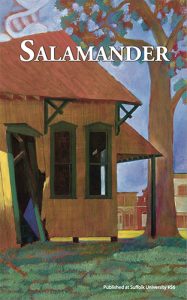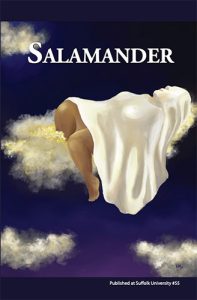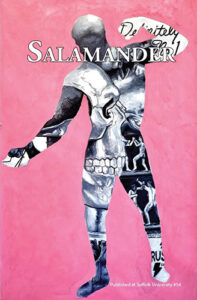Salamander – Summer 2009
Volume 14 Number 2
Summer 2009
Biannual
Sima Rabinowitz
You’ll always find a few big stars in Salamander (Chase Twichell, Maura Stanton, Michael Collins). What’s more important, though, is that you’ll always find some stellar work. And this issue is no exception. I am thrilled to see two poems from Catherine Sasanov’s new collection, Had Slaves. I heard her read from this book last year prior to its publication and was quite taken with these spare (with the exception of their titles!), beautifully composed, and astoundingly moving poems about a family history of slave ownership.
You’ll always find a few big stars in Salamander (Chase Twichell, Maura Stanton, Michael Collins). What’s more important, though, is that you’ll always find some stellar work. And this issue is no exception. I am thrilled to see two poems from Catherine Sasanov’s new collection, Had Slaves. I heard her read from this book last year prior to its publication and was quite taken with these spare (with the exception of their titles!), beautifully composed, and astoundingly moving poems about a family history of slave ownership.
This issue of the journal includes two from the book, “Line Drawing of Ex-Slave, Columbia Bigbee, 1840-1899, Consisting of Ink Lifted from Newsprint, Census Data, Burial Records, Divorce Proceedings, Tax Rolls, Marriage Licenses, Land Deeds, and One Civil War Widow’s Pension Application: Denied” and “Revisionist (History).” Sasanov demonstrates here, as she has in the past, that it is possible to tell a story in verse that takes advantage of what makes poetry so powerful, its magnificent potential for restraint, economy, and a kind of emotional precision that nearly defies comprehension. Sasanov reminds us that poetry is not merely narrative broken into lines, yet she manages to make poetry work as story and as history.
Poems by Julia Lisella, Melissa Apperson, and Taylor Altman impressed me for other reasons, principally a taut energy that moved the verse beyond the merely “accessible” into a heightened realm that was approachable, but not ordinary. And I was especially moved by a poem from Ellen Kaufman, “Emergency,” because I seldom find poems written from the perspective of parents about their children to be of interest (often they are merely sentimental anecdotes), and this one is exceptionally fine. Kaufman’s “Emergency” manages to create a rhythm of urgency supported by images that are thoughtfully and successfully played out across the poem’s two dozen lines.
This issue also includes four short stories by Geoff Kronik, Siobhan Fallon, Aaron Hellem, and Christine Dywer Hicky, all of which are competent, traditional narratives, but none of which seemed as exciting to me as the poetry in this issue. Finally, editor Jennifer Barber interviews fiction writer Edward P. Jones, who discusses the inspiration for his characters and the relationship between his books. He doesn’t admit he thinks much about peoples’ mysterious nature outside of his books. “The world is out there, and I’m in here, and that’s all I know,” he says. Salamander knows how to bring the world “out there” to a place “in here” – a place you’ll want to go.
[media.cas.suffolk.edu/salamander/]




